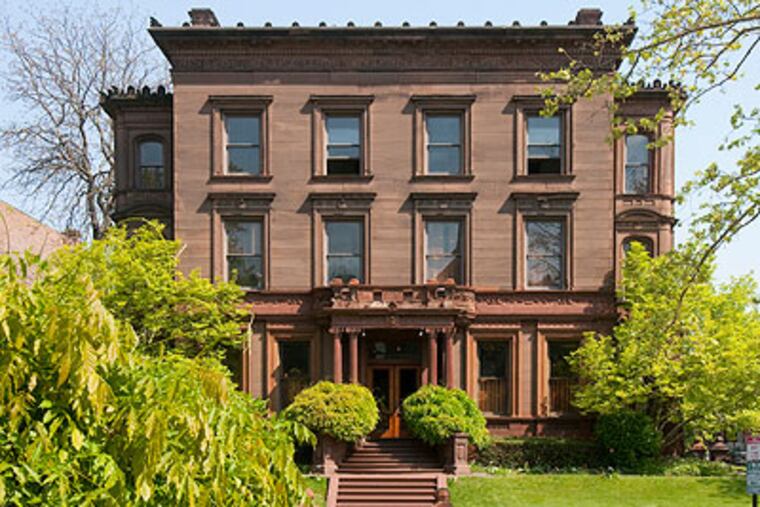A dream, for rent or sale
As Siriak Zakarian guides a visitor through room after room of the mansion she's spent 21 years lovingly and painstakingly restoring, the sadness in her voice is easy to discern.

As Siriak Zakarian guides a visitor through room after room of the mansion she's spent 21 years lovingly and painstakingly restoring, the sadness in her voice is easy to discern.
The reason for that sadness is simple: The Bergdoll Mansion, the three-story Victorian jewel that crowns a terraced lot on the 2200 block of Green Street, is not yet finished, but its mortgage is crushing her.
Zakarian's choice: Find tenants for the six apartments she has carefully carved from the huge rooms on the second and third floors, or sell her brownstone treasure for $6.995 million.
"I've had difficulty renting the apartments," she said, eager to steer the conversation back to the work that has cost about $5.5 million since she rescued the 120-year-old, 15,000-square-foot-house in 1989 from developers after it had been heavily damaged by fire and looted by thieves. She paid $300,000 for it.
Zakarian, a biochemist, has brought in Kurfiss Sotheby's International Realty of New Hope to find tenants or a buyer for the house as a single-family home.
Kurfiss chairman Donald D. Pearson and agent Patricia Royston have grown to share Zakarian's love for the dwelling and are looking for prospective renters of the $2,200- to $3,200-a-month apartments in the second-floor library and third-floor billiard room, with its spectacular views of Center City. (Parking is available on the property.)
"Every time I visit, I find something new," Royston said, acknowledging that even with the assistance of an appraiser, it was difficult to put a price on Zakarian's efforts.
In a housing market still very much on the slow side, prospects for both renters and buyers, while not out of the question, are daunting.
Well-heeled buyers are gravitating to the high-rises of Center City, willing to pay $7.6 million for half a floor of Two Liberty Place or $12.5 million for a yet-to-close penthouse at 1706 Rittenhouse Square Street.
Jumbo mortgages, with a one-unit conforming limit in this area of $417,000, are difficult to obtain and costly. And unless you are one of the estimated 2,000 Philadelphia-area residents worth $20 million or more, all-cash purchases are impossible.
The Spring Garden neighborhood surrounding the venerable mansion benefited mightily from both the urban-pioneer movement of the 1970s and the real estate boom of a few years ago, which pushed up prices for shells to $400,000-plus, yet for-sale signs are very much in evidence.
Though Zakarian's house is very much its own world, as even a quick glance through the front doors reveals, it is still a piece of real estate, subject to all the current, less-than-predictable market forces.
This is not a house for everyone. Its new owner will, ideally, be someone willing to commit to preserving and maintaining a piece of 19th-century Philadelphia.
As she moves from room to room, Zakarian ticks off an almost endless list of craftsmen who have been a part of the restoration of the mansion, built by railroad magnate and Pennsylvania Treasury Secretary James Kemble in 1890: plaster restoration by Felber Studios of Ardmore; gilded mirrors by Matthew Szczepanowski; chandeliers rebuilt by Harvey Stern, just to name three.
Stories she tells about each room could fill a book.
The basement, with hundreds of shutters awaiting a carpenter's return, had evidence of the coal, wood, and steam furnaces that heated the mansion until Zakarian replaced it all with a modern system.
Near the wine cellar are three cast-iron tanks that once were used to purify water - and were too heavy to move. One of the 10 bathrooms - there were three when she started - held a wooden refrigerator four feet below the basement floor.
Each bathroom cost $50,000, she said.
Zakarian's ties to the house stretch to her childhood, when it was owned by brothers Louis and Wilbur Bergdoll, whose brewery-owning family bought it at auction from Kemble's widow in 1906.
Zakarian's great-uncle lived there. And she had an apartment there in the 1960s, when she was in college and graduate school.
She left after graduating, but returned in 1986 and rented her great-uncle's apartment from the Bergdoll brothers. She now occupies the spacious first floor and the basement.
In February 1989, the fire (and firefighters' efforts to extinguish it) heavily damaged the house. Water pipes froze in subzero temperatures and burst through the walls and ceilings when the weather warmed. Thieves stole lighting fixtures; vandals smashed glass and Tiffany windows.
"All except this," Zakarian said, pointing to an oval Tiffany window restored to perfection in the sunroom, which was built on the ruins of the greenhouse.
"It was behind boards," she explained, "and was missed."